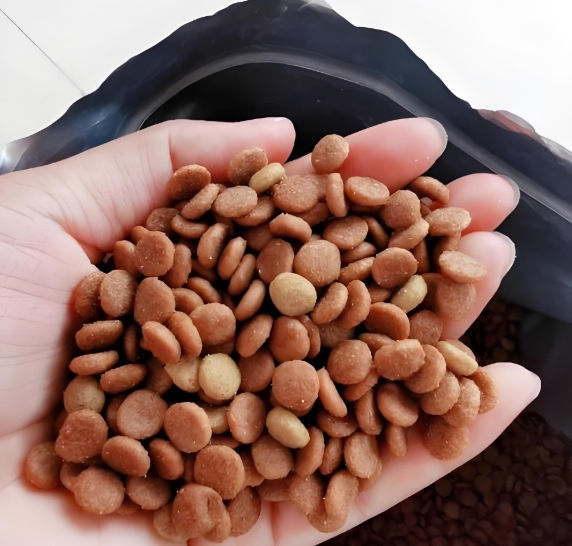How Dog Food Gets Its Shape: The Production of Multi-Shaped Kibble
The variety of shapes in dry dog food—from simple rounds and ovals to intricate bones, stars, and even cartoon characters—is not just for fun. These shapes can influence palatability, chewing mechanics, and market appeal. The creation of these diverse forms is a fascinating feat of engineering and food science, primarily centered around one key piece of equipment: the extruder.
Here’s a detailed look at how manufacturers produce dog food in multiple shapes.
1. The Heart of the Process: The Extruder and Die Plate
The ability to create different shapes is fundamentally determined at the very end of the extrusion process.
- The Extruder: A mixture of ingredients (meals, grains, vitamins) is ground, hydrated, and cooked under high pressure and temperature inside the extruder barrel. This process gelatinizes the starches and creates a molten, dough-like mass.
- The Die Plate: This is the crucial component for shaping. It is a thick, metal disk installed at the end of the extruder barrel. The die plate is perforated with precisely machined holes, each cut into a specific cross-sectional shape.
2. How Specific Shapes Are Formed
The shape of the hole in the die plate dictates the shape of the kibble. As the hot, pressurized dough is forced through these holes, it takes on their form, emerging as long, continuous strands of that shape.
- Simple Shapes: Round kibble is made using a die with simple cylindrical holes. Oval shapes are created using oval holes.
- Complex Shapes (Bones, Stars, etc.): Creating a bone-shaped piece requires a die hole that is itself bone-shaped in cross-section. The same applies to stars, triangles, or any other custom design. The complexity is limited only by the ability to machine the die and ensure the dough flows through evenly without clogging.
3. The Cutting Mechanism: Creating Individual Pieces
Once the shaped dough exits the die, it must be cut into individual pieces. This is done by a high-speed rotary cutter—a blade that spins directly against the face of the die plate.
- Cutting Speed: The speed of this cutter is precisely controlled. A faster cutting speed results in thinner, smaller pieces. A slower speed results in thicker, larger pieces.
- Synchronicity: The cutter can be synchronized to create specific patterns, like a “kiss-cut” where pieces are partially connected, often used for treats.
4. Expansion: The “Puff” and Final Form
The moment the cooked dough exits the die and is cut, it experiences a sudden drop to atmospheric pressure. This causes the superheated moisture within the dough to flash into steam, rapidly expanding the piece.
- This expansion is critical. It gives kibble its light, airy texture and final size. A piece cut as a small star will puff into a larger, easier-to-see star shape.
- The recipe (especially starch content) and processing conditions (temperature and pressure) are carefully calibrated to control this expansion and ensure the intricate shape is maintained and not distorted.
5. Post-Processing: Drying and Coating
After cutting and expansion, the soft, moist-shaped pieces are not yet stable.
- Drying: They are conveyed through a multi-pass dryer, where warm air circulates to reduce the moisture content to a shelf-stable level (~10%). This process hardens the kibble, “setting” its shape and giving it the characteristic crunch.
- Coating: Finally, the hardened kibble is tumbled in a drum and coated with a fine mist of digestible fats, oils, flavor enhancers, and sometimes a powder of heat-sensitive vitamins and minerals that may have been degraded during the high-heat extrusion process. This coating enhances palatability without altering the kibble’s physical shape.
Summary: The Steps to a Shape
- Design & Machining: A die plate is custom-machined with holes in the desired cross-sectional shape.
- Extrusion: The ingredient dough is forced under pressure through the die plate, emerging as continuous strands of that shape.
- Cutting: A high-speed rotary cutter slices the strands into individual pieces of precise length.
- Expansion: The pieces instantly expand (“puff”) due to the pressure change, achieving their final size.
- Drying & Hardening: The pieces are dried in an oven, hardening them and locking in their shape and texture.
- Coating: Fats and flavors are applied to the finished shapes.
Beyond Extrusion: Alternative Methods
While extrusion is the most common method for creating shaped dry food, other processes exist:
- Baking: A dough is prepared, rolled out, and cut into shapes with mechanical dies (like cookie cutters) before being baked in an oven. This method is common for harder biscuits and treats and can produce very detailed, embossed shapes.
- Cold-Pressing: This method uses pressure instead of heat to form a dough into dense pellets. While it can produce different shapes (e.g., small rounds or ovals), it is not typically used for highly intricate designs because the product does not expand, making fine details less visible.
In conclusion, the production of multi-shaped dog food is a precise marriage of mechanical engineering and food science. It allows pet food companies to create not only nutritionally complete food but also products that are engaging for pets and appealing to their owners, demonstrating that functionality and fun can indeed come in the same bag.








